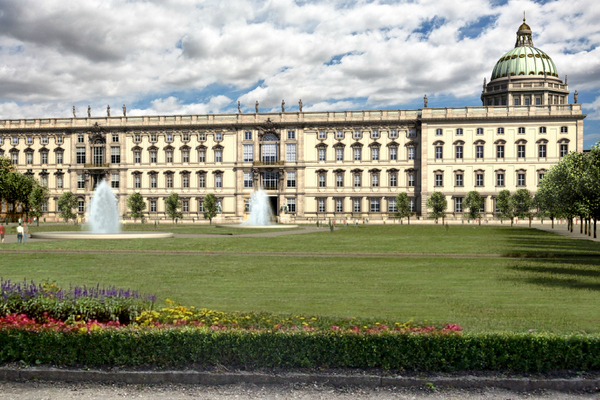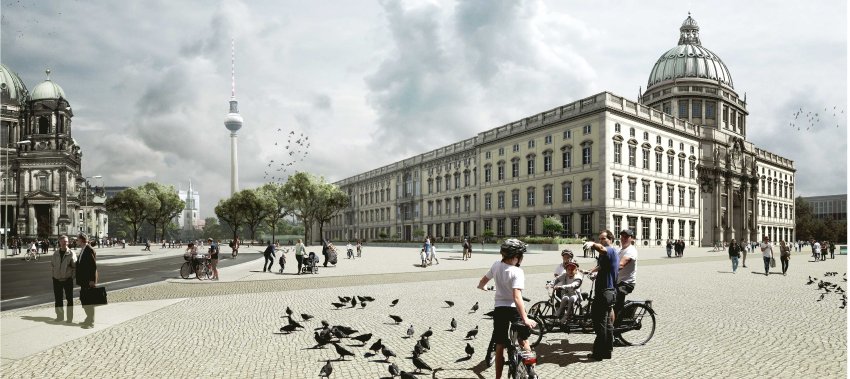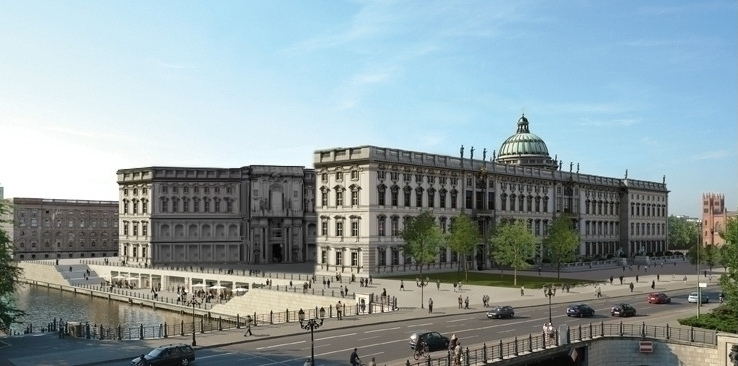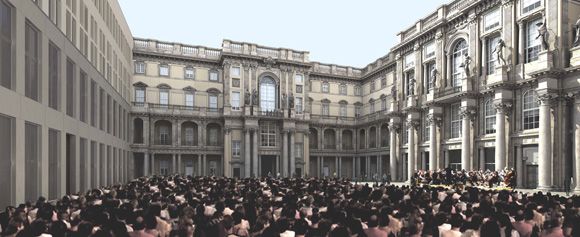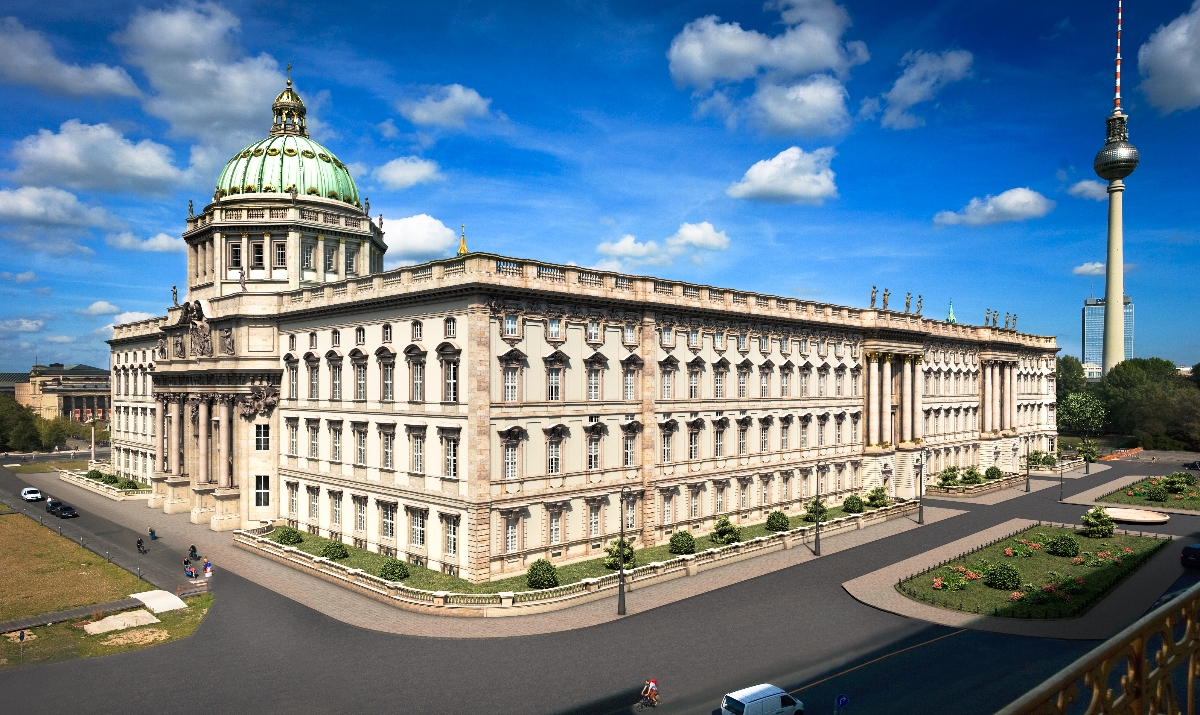The Berlin City Palace (German: Berliner Stadtschloss) was a royal and imperial palace in the centre of Berlin, the historical capital of Prussia, and subsequently Germany. It was located on the Museum Island at Schlossplatz, opposite the Lustgarten park. It was the winter residence of the Kings of Prussia and the German Emperors. In 2013 work started on reconstruction and a part of the exterior of the palace has been rebuilt. The completion is expected in 2019.
The palace was originally built in the 15th century and changed throughout the next few centuries. It bore features of the Baroque style, and its shape, finalised by the middle 18th century, is attributed to German architect Andreas Schlüter, whose first design is likely to date from 1702, though the palace incorporated earlier parts seen in 1688 by Nicodemus Tessin. It served as a residence to various Electors of Brandenburg. It was the principal residence and winter residence of the Hohenzollern Kings of Prussia from 1701 to 1918. After the unification of Germany in 1871, it was also the central residence for the German Emperors. It became a museum following the fall of the German Empire in 1918. The palace was heavily damaged by Allied bombing in World War II. Although it could have been repaired at great expense, the palace was demolished in 1950 by the German Democratic Republic authorities, despite West German protests.
Following the reunification of Germany, it was decided to rebuild the entire exterior of the palace in the original style except for one side. The new building will have the cubature of the former palace and include authentically reconstructed facades on three of the four exterior sides of the building. The interior will be modern, but the facades of one of the courts will be in the original style (Schlüterhof). However, the floorplan has been designed to allow potential future reconstruction of notable historical rooms. The building will house the Humboldtforum museum and congress complex, and is scheduled to be finished 14 September 2019.
History up to 1871
The palace replaced an earlier fort or castle guarding the crossing of the Spree river at Cölln, a neighboring town which merged with Berlin in 1710. The castle stood on Fishers’ Island, as the southern end of the Museum Island in the Spree is known. In 1443 Frederick II "Irontooth", Margrave and Prince Elector of Brandenburg, laid the foundations of Berlin's first fortification in a section of swampy wasteland north of Cölln. At the completion of the castle in 1451, Frederick moved there from the town of Brandenburg. The main role of the castle and its garrison in this period was to establish the authority of the Margraves over the unruly citizens of Berlin, who were reluctant to give up their medieval privileges to a monarchy. In 1415 King Sigismund had enfeoffed the Hohenzollern princes with Brandenburg, and they were now establishing their power and withdrawing electoral privileges which the cities had attained in the Brandenburg interregnum of 1319–1415.
The castle also included a chapel . In 1454 Frederick II, after having returned via Rome from his pilgrimage to Jerusalem, made the castle chapel a parish church, richly endowing it with relics and altars. Pope Nicholas V ordered Stephan Bodecker, then Prince-Bishop of Brandenburg, to consecrate the Chapel to Erasmus of Formiae.
On 7 April 1465, at Frederick's request, Pope Paul II attributed to St Erasmus Chapel a canon-law College named Stift zu Ehren Unserer Lieben Frauen, des heiligen Kreuzes, St. Petri und Pauli, St. Erasmi und St. Nicolai. This collegiate church became the nucleus of today's Evangelical Supreme Parish and Collegiate Church, adjoining the site of the castle.
In 1538, the Margrave Joachim II demolished the palace and engaged the master builder Caspar Theiss to build a new and grander building in the Italian Renaissance style. After the Thirty Years War (1618–1648), Frederick William (1620–1688), the "Great Elector", embellished the palace further. In 1688, Nicodemus Tessin designed courtyard arcades with massive columns in front. Not much is known about the alterations of 1690–1695, when Johann Nering was the court architect. Martin Grünberg continued the alterations in 1695–1699.
In 1699 the Elector Frederick III of Brandenburg (who took the title King in Prussia in 1701, becoming Frederick I), appointed the architect Andreas Schlüter to execute a "second plan" in the Italian manner. Schlüter's first design probably dates from 1702; he planned to rebuild the palace in the Protestant Baroque style. His overall concept in the shape of a regular cube enclosing a magnificently ornamented courtyard was retained by all the building directors who succeeded him. In 1706, Schlüter was replaced by Johann Friedrich Eosander von Göthe, who designed the western extension of the palace, doubling its size. In all essentials, Schlüter's balanced, rhythmic composition of the façades was retained, but Göthe moved the main entrance to the new west wing.
Frederick William I, who became king in 1713, was interested mainly in building up Prussia as a military power, and dismissed most of the craftsmen working on the Stadtschloss. As a result, Göthe's plan was only partly carried out. Nevertheless, the exterior of the palace had come close to its final form by the mid-18th century. The final stage was the erection of the dome in 1845, during the reign of Frederick William IV. The dome was built by Friedrich August Stüler after a design by Karl Friedrich Schinkel. Subsequent major works were limited to the interior, engaging the talents of Georg Wenzeslaus von Knobelsdorff, Carl von Gontard and many others.
The Stadtschloss was at the centre of the Revolution of 1848 in Prussia. Huge crowds gathered outside the palace to present an "address to the king" containing their demands for a constitution, liberal reform and German unification. Frederick William emerged from the palace to accept their demands. On March 18, a large demonstration outside the Stadtschloss led to bloodshed and the outbreak of street fighting. Frederick William later reneged on his promises and reimposed an autocratic regime. From that time onwards, many Berliners and other Germans came to see the Stadtschloss as a symbol of oppression and "Prussian militarism".
Reconstruction
Following reunification a long-running debate commenced as to whether the palace should be reconstructed, and whether this should be in part or whole. Pro-reconstruction lobby groups argued that the rebuilding of the Stadtschloss would restore the unity and integrity of the historical centre of Berlin, which includes the Berliner Dom, the Lustgarten and the museums of Museum Island. Opponents of the project included those who advocated the retention of the Palast der Republik on the grounds that it was itself of historical significance; those who argued that the area should become a public park; and those who believed that a new building would be a pastiche of former architectural styles; would be an unwelcome symbol of Germany’s imperial past; and would be unacceptably expensive for no definite economic benefit. They also argued that it would be impossible to accurately reconstruct the exterior or interiors of the building, since neither detailed plans nor the necessary craft skills are available. Others disputed this, claiming that sufficient photographic documentation of both existed when it was converted to a museum following 1918.
The driving force in ultimately achieving reconstruction of the Stadtschloss was a Hamburg businessman and aristocrat Wilhelm von Boddien, described as "a great communicator". In 1992 von Boddien founded and became Chairman of what became the most influential lobby group, Förderverein Berliner Schloss eV – Friends Of The Berlin Schloss. Boddein's group accumulated plans that had been believed lost, and funded a research project at the Technical University of Berlin to measure surviving photos and drawings of the Palace to create precise architectural plans. In 1993, it pulled off a further remarkable achievement, erecting a canvas mockup of a portion of the Stadtschloss facades in 1: 1 scale on the world's largest scaffolding assembly. Privately funded by donations and sponsorship it stood for a year and half, and is considered to be what turned public and official opinion in favour of reconstruction.
In view of the previous opposition, including high cost, and most importantly, the psychological and political objections, successive German governments had declined to commit themselves to the project. However, by 2002 and 2003 cross-party resolutions of the Bundestag reached a compromise to support at least a partial rebuilding of the Stadtschloss. In 2007, the Bundestag (German parliament) made a definitive decision about the reconstruction. According to this compromise, three façades of the palace would be rebuilt, but the interior is to be a modern structure to serve as a cultural museum and forum. However, the proportions of many of the original state rooms have been retained so as to enable their reconstruction at a later date should this be desired. Reconstruction of the Renaissance-gabled Pharmacy Wing, which connected to the Stadtschloss on the north side, would be another possible future project.
Due to German government budget cuts, construction of the 'Humboldtforum', as the new palace is called, was delayed. The foundation stone was finally laid by President Joachim Gauck in a ceremony on 12 June 2013 signalling the launch of a €590m (£500m) reconstruction project. On completion in 2019 the building will house a modern museum containing collections of African and other non-European art, as well as two restaurants, a theater, a movie theater and an auditorium. Donations continue to be sought for the baroque facade decoration by Förderverein Berliner Schloss eV, which is funding this part of the reconstruction.




